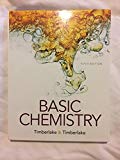
Concept explainers
Assign oxidation numbers to all the elements in each of the following reactions, and identify the reactant that is oxidized, the reactant that is reduced, the oxidizing agent, and the reducing agent: (15.1)
a.
b.
c.
Want to see the full answer?
Check out a sample textbook solution
Chapter 15 Solutions
Basic Chemistry - Fifth Edition
- Methane, CH4, reacts with oxygen to produce carbon dioxide, water, and heat. CH4(g) + 2O2(g) CO2(g) + 2H2O(l) ΔH = – 890.3 kJ What is the value of ΔH if 5.00 g of CH 4 is combusted?arrow_forwardCalculate the ΔGo (in kJ/mol) for the following reaction at 25.0℃.2Cr+3(aq)+2Mg(s)→2Cr(s)+3Mg+2(aq)arrow_forwardWhen 40.2 g of HgO (MM = 216.6 g/mol) decompose, 16.9 kJ of energy is absorbed. Calculate ΔHrxn in kJ for reaction of 2 moles of HgO according to this balanced equation: 2 HgO(s) → 2 Hg(l) + O2(g)arrow_forward
- Deterioration of buildings, bridges, and other structures through the rusting of iron costs millions of dollars every day. Although the actual process also requires water, a simplified equation (with rust shown as Fe2O3) is:4 Fe(s) + 3 O2(g) → 2 Fe2O3(s) ΔHrxn = −1.65 × 103 kJ (a) What is the ΔHrxn when 0.250 kg of iron rusts?arrow_forwardDeterioration of buildings, bridges, and other structures through the rusting of iron costs millions of dollars every day. Although the actual process also requires water, a simplified equation (with rust shown as Fe2O3) is: 4 Fe(s) + 3 O2(g) → 2 Fe2O3(s) Δ Hrxn = −1.65 × 103 kJ (a) What is the ΔHrxn when 0.250 kg of iron rusts?arrow_forwardBalance & calculate ΔH°(tot) from ΔHf°’s in T6.5 and listed below: 1) _KMnO4(s) + __HCl(g) → _KCl(s) + _H2O(g) + _Cl2(g)+ _MnO2(s) ΔHf°(KMnO4) = –837.2 kJ/mol, ΔHf°(MnO2) = –520.0 kJ/mol ΔH°(tot) = _______ kJ 2)_N2(g) + _O2(g) → _NO(g) ΔH°(tot) = ________ kJarrow_forward
- How much heat (in kilocalories) is evolved or absorbed in the reaction of 1.21 g of Na with H2O?2Na(s)+2H2O(l)→2NaOH(aq)+H2(g), ΔHΔH = -88.0 kcalkcal (-368 kJ)arrow_forwardCalculate the ∆G for the reaction at 25° C 2SO2(g) + O2(g) → 2SO3(g)arrow_forwardIn the following reaction, identify the reactant that is oxidized and the reactant that is reduced: 2FeO(s) → 2Fe(s) + O2(g) Half-equations: for Fe2+ in FeO: 2Fe2+ + 4e–→ 2Fe for O2– in FeO: 2O2–→ O2 + 4e– A. Fe2+ in FeO is reduced, while O2– in FeO is oxidized. B. Fe2+ in FeO is oxidized, while O2– in FeO is reduced. C. Both Fe2+ and O2– in FeO are oxidized. D. Both Fe2+ and O2– in FeO are reduced.arrow_forward
- Balance & calculate ΔH°(tot) from ΔHf°’s in T6.5 and listed below: __NH3(g) + __O2(g) → __NO(g) + __H2O(g) ΔH°(tot) = ____kJarrow_forward1. Balance the following chemical equation: Fe2O3 + CO ------> Fe + CO2, answers are listed in order - 1st coefficient, 2nd coeficient, etc. and so on. (1st one is in front of Fe2O3, 2nd one in front of CO, etc. and so on) Group of answer choices a) 1,3,3,2 b) 2,3,2,3 c) 1,3,2,3 d) 1,2,2,2arrow_forwardGlutathione (G-SH), one of the most common tripeptides in animals, plants, and bacteria, is a scavenger of oxidizing agents. In reacting with oxidizing agents, glutathione is converted to G-S-S-G. Q. Write a balanced half-reaction for the reaction of two molecules of glutathione to form a disulfide bond. Is glutathione a biological oxidizing agent or a biological reducing agent?arrow_forward
 ChemistryChemistryISBN:9781305957404Author:Steven S. Zumdahl, Susan A. Zumdahl, Donald J. DeCostePublisher:Cengage Learning
ChemistryChemistryISBN:9781305957404Author:Steven S. Zumdahl, Susan A. Zumdahl, Donald J. DeCostePublisher:Cengage Learning ChemistryChemistryISBN:9781259911156Author:Raymond Chang Dr., Jason Overby ProfessorPublisher:McGraw-Hill Education
ChemistryChemistryISBN:9781259911156Author:Raymond Chang Dr., Jason Overby ProfessorPublisher:McGraw-Hill Education Principles of Instrumental AnalysisChemistryISBN:9781305577213Author:Douglas A. Skoog, F. James Holler, Stanley R. CrouchPublisher:Cengage Learning
Principles of Instrumental AnalysisChemistryISBN:9781305577213Author:Douglas A. Skoog, F. James Holler, Stanley R. CrouchPublisher:Cengage Learning Organic ChemistryChemistryISBN:9780078021558Author:Janice Gorzynski Smith Dr.Publisher:McGraw-Hill Education
Organic ChemistryChemistryISBN:9780078021558Author:Janice Gorzynski Smith Dr.Publisher:McGraw-Hill Education Chemistry: Principles and ReactionsChemistryISBN:9781305079373Author:William L. Masterton, Cecile N. HurleyPublisher:Cengage Learning
Chemistry: Principles and ReactionsChemistryISBN:9781305079373Author:William L. Masterton, Cecile N. HurleyPublisher:Cengage Learning Elementary Principles of Chemical Processes, Bind...ChemistryISBN:9781118431221Author:Richard M. Felder, Ronald W. Rousseau, Lisa G. BullardPublisher:WILEY
Elementary Principles of Chemical Processes, Bind...ChemistryISBN:9781118431221Author:Richard M. Felder, Ronald W. Rousseau, Lisa G. BullardPublisher:WILEY





